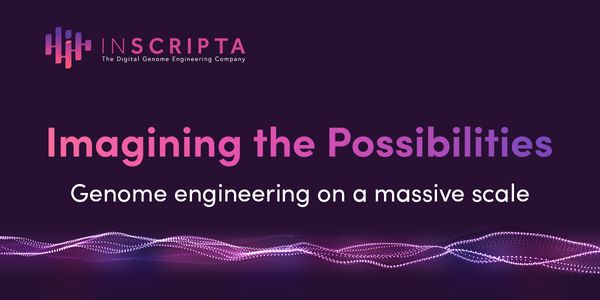Networks
A network is defined as the connection of at least two computer systems, either by a cable or a wireless connection. The simplest network is a combination of two computers connected by a cable.
-
MAY 14, 2020 | 10:00 AMDATE: May 14, 2020 TIME: 10:00am PT, 1:00pm ET Massively parallel genome engineering enables rapid and simultaneous evaluation of genotype-phenotype relationships at a genomic scale....MAY 14, 2020 | 3:00 PMIncreasing evidence suggests that targeted sequencing of cell free DNA (cfDNA) can provide a comprehensive molecular portrait of solid tumors. However, the concordance between tissue and cfD...MAY 14, 2020 | 3:00 PMIncreasing evidence suggests that targeted sequencing of cell free DNA (cfDNA) can provide a comprehensive molecular portrait of solid tumors. However, the concordance between tissue and cfD...MAY 06, 2020 | 12:00 AMThe ever-increasing number of deaths along the U.S.-México border and the diversification in the demographic characteristics of the Latin American migrants, who perish in this region,...MAY 06, 2020 | 12:00 AMThe necrobiome is the community of organisms that use or are affected by decomposing organic matter. Decomposing organic matter comes in the form of dead plant matter (biomass) or that of de...APR 29, 2020 | 6:00 AMHistone post-translational modifications (PTMs) play pivotal roles in chromatin dynamics and function, with alterations in the healthy profile associated with diverse human pathologies. The...Speaker: Michael-Christopher Keogh, PhDPresented at: xMAP® Connect Virtual Conference (On-Demand)
APR 29, 2020 | 6:00 AMTranslational medicine has been fairly unsuccessful in translating innovation from the lab towards the clinics and back again. Many reasons account for the failure leading to a massive waste...APR 29, 2020 | 6:00 AMBackground and aim: Denmark is a world-wide leading country for the export of swine abroad: Annually 12 mio pigs (nucleus pigs, breeding sows, slaughter pigs and carcasses) are being exporte...APR 23, 2020 | 9:00 AMLearning Objectives: 1. What is wrong with healthcare today 2. What kinds of omics and wearables data can be used to best predict disease risk and manage health...APR 22, 2020 | 9:00 AMSingle-cell RNA sequencing has emerged as an important technology that can reveal gene expression differences between different cell types. This webinar will demonstrate how bioinformatics s...Speaker: Jean-Noel Billaud, PhDAPR 22, 2020 | 8:00 AMC.E. CREDITSRapid access to high quality comprehensive coagulation test results is critical to patient care. In an environment where clinical laboratories constantly experience price and labor pressure,...Speaker: Eleanor Herriman, MD, MBA , Oksana Volod, MDAPR 22, 2020 | 12:00 AMAchieving a diagnosis in rare disease patients can be challenging for even the most experienced clinician or scientist, creating a barrier to delivering truly personalised care. An exome seq...APR 14, 2020 | 9:00 AMDATE: April 14, 2020 TIME: 9:00am PDT, 12:00pm EDT Besides being Gibco Cell Culture Heroes, what do Vivek, Sandra, Daisy, Ameet and Kristine all have in common? They are all stuck at home fo...Speaker: Kristine Wadosky, PhD , Ameet Chimote, PhD , Elizabeth Delery, PhD , Daisy Shu, B.Optom, PhD , Vivek Kamat, PhD , Sandra Hammer, PhDSponsored By: Thermo Fisher Scientific/GibcoAPR 02, 2020 | 2:30 PMScientists worldwide are actively working to tame the COVID-19 pandemic by developing therapies for patients with severe disease and a vaccine to stem transmission. Accomplishing these two g...APR 02, 2020 | 7:30 AMLearning Objectives: 1. What kind of virus is the coronavirus? Where is its greatest vulnerability and why? 2. What differentiated the HCoVs discovered in the 1960s from the SARS-CoV and MER...MAR 27, 2020 | 9:00 AMDATE: March 27, 2020 TIME: 9:00am PDT, 12:00pm EDT Osteoporosis causes a decrease in bone density, along with deterioration of the bone’s microarchitecture at a faster rate than normal...MAR 11, 2020 | 3:00 PMWorking memory (the ability to hold some information in mind for a few seconds, and to manipulate that information) and decision-making (committing to one out of multiple possible choices) a...Speaker: Carlos Brody, PhD , Ben Engelhard, PhD , Stephen Keeley, PhD , Marlies Oostland, PhD , Lucas Pinto, MD, PhD , Adrian Wanner, PhD , Ilana Witten, PhDPresented at: Neuroscience Virtual Event Series 2020
MAR 11, 2020 | 3:00 PMIdentifying the diversity of neuronal cell types of the nervous system is one of the main objectives of the BRAIN Initiative, with the vision that distinct neuronal identities will allow for...Speaker: Giorgio Ascoli, PhD , Hong-Wei Dong, MD, PhD , Byungkook Lim, PhDPresented at: Neuroscience Virtual Event Series 2020
MAR 11, 2020 | 12:00 PMMechanistic understanding of neural systems is daunting to achieve in large part due to the heterogeneity of the neuronal elements in both form and function and the complexity of the circuit...Speaker: Emre Aksay, PhD , Mark Goldman, PhD , Sebastian Seung, PhD , Ashwin Vishwanathan, PhDPresented at: Neuroscience Virtual Event Series 2020
MAR 11, 2020 | 10:30 AMThe accumulation of neurotoxic amyloid beta peptides and/or neurofibrillary tangle formation are key pathological hallmarks of neurodegenerative diseases including but not limited to Alzheim...Speaker: Michael Heneka, PhDMAR 11, 2020 | 10:30 AMThe neural basis of simple rhythmic and reflexive behaviors such as swimming and gill withdrawal have been successfully studied in nudibranchs and other gastropod molluscs because the brains...Speaker: Paul Katz, PhD , Jeff Lichtman, MD, PhD , William Frost, PhD , Deidre Lyons, PhD , Vince Lyzinski, PhD, B.Sc, M.Sc, M.Sc.E.Presented at: Neuroscience Virtual Event Series 2020
MAR 11, 2020 | 10:30 AMThe public health burden of Treatment Resistant Depression (TRD) has prompted clinical trials of deep brain stimulation (DBS) that have, unfortunately, produced inconsistent outcomes. Potent...Speaker: Wayne Goodman, MD , Nader Pouratian, MD, PhD , Sameer Anil Sheth, MD, PhDPresented at: Neuroscience Virtual Event Series 2020
MAR 11, 2020 | 9:00 AMAlthough neuroscience has provided a great deal of information about how neurons work, the fundamental question of how neurons function together in a network to produce cognition has been di...Speaker: György Buzsáki, PhD , Attila Losonczy , Mark Schnitzer , Ivan SolteszPresented at: Neuroscience Virtual Event Series 2020
MAR 11, 2020 | 6:00 AMWe present here a framework to generate a realistic multiscale circuit model of the larval zebrafish brain – the multiscale virtual fish (MVF). The model will be based on algorithms in...Speaker: Florian Engert, PhD , Jeff Lichtman, MD, PhD , Haim SompolinskyPresented at: Neuroscience Virtual Event Series 2020
MAY 14, 2020 | 10:00 AM
DATE: May 14, 2020 TIME: 10:00am PT, 1:00pm ET Massively parallel genome engineering enables rapid and simultaneous evaluation of genotype-phenotype relationships at a genomic scale....
MAY 14, 2020 | 3:00 PM
Increasing evidence suggests that targeted sequencing of cell free DNA (cfDNA) can provide a comprehensive molecular portrait of solid tumors. However, the concordance between tissue and cfD...
MAY 14, 2020 | 3:00 PM
Increasing evidence suggests that targeted sequencing of cell free DNA (cfDNA) can provide a comprehensive molecular portrait of solid tumors. However, the concordance between tissue and cfD...
MAY 06, 2020 | 12:00 AM
The ever-increasing number of deaths along the U.S.-México border and the diversification in the demographic characteristics of the Latin American migrants, who perish in this region,...
MAY 06, 2020 | 12:00 AM
The necrobiome is the community of organisms that use or are affected by decomposing organic matter. Decomposing organic matter comes in the form of dead plant matter (biomass) or that of de...
APR 29, 2020 | 6:00 AM
Histone post-translational modifications (PTMs) play pivotal roles in chromatin dynamics and function, with alterations in the healthy profile associated with diverse human pathologies. The...
Speaker:
Michael-Christopher Keogh, PhD
Presented at: xMAP® Connect Virtual Conference (On-Demand)
APR 29, 2020 | 6:00 AM
Translational medicine has been fairly unsuccessful in translating innovation from the lab towards the clinics and back again. Many reasons account for the failure leading to a massive waste...
APR 29, 2020 | 6:00 AM
Background and aim: Denmark is a world-wide leading country for the export of swine abroad: Annually 12 mio pigs (nucleus pigs, breeding sows, slaughter pigs and carcasses) are being exporte...
APR 23, 2020 | 9:00 AM
Learning Objectives: 1. What is wrong with healthcare today 2. What kinds of omics and wearables data can be used to best predict disease risk and manage health...
APR 22, 2020 | 9:00 AM
Single-cell RNA sequencing has emerged as an important technology that can reveal gene expression differences between different cell types. This webinar will demonstrate how bioinformatics s...
Speaker:
Jean-Noel Billaud, PhD
APR 22, 2020 | 8:00 AM
C.E. CREDITS
Rapid access to high quality comprehensive coagulation test results is critical to patient care. In an environment where clinical laboratories constantly experience price and labor pressure,...
Speaker:
Eleanor Herriman, MD, MBA
, Oksana Volod, MD
APR 22, 2020 | 12:00 AM
Achieving a diagnosis in rare disease patients can be challenging for even the most experienced clinician or scientist, creating a barrier to delivering truly personalised care. An exome seq...
APR 14, 2020 | 9:00 AM
DATE: April 14, 2020 TIME: 9:00am PDT, 12:00pm EDT Besides being Gibco Cell Culture Heroes, what do Vivek, Sandra, Daisy, Ameet and Kristine all have in common? They are all stuck at home fo...
Speaker:
Kristine Wadosky, PhD
, Ameet Chimote, PhD
, Elizabeth Delery, PhD
, Daisy Shu, B.Optom, PhD
, Vivek Kamat, PhD
, Sandra Hammer, PhD
Sponsored By: Thermo Fisher Scientific/Gibco
APR 02, 2020 | 2:30 PM
Scientists worldwide are actively working to tame the COVID-19 pandemic by developing therapies for patients with severe disease and a vaccine to stem transmission. Accomplishing these two g...
APR 02, 2020 | 7:30 AM
Learning Objectives: 1. What kind of virus is the coronavirus? Where is its greatest vulnerability and why? 2. What differentiated the HCoVs discovered in the 1960s from the SARS-CoV and MER...
MAR 27, 2020 | 9:00 AM
DATE: March 27, 2020 TIME: 9:00am PDT, 12:00pm EDT Osteoporosis causes a decrease in bone density, along with deterioration of the bone’s microarchitecture at a faster rate than normal...
MAR 11, 2020 | 3:00 PM
Working memory (the ability to hold some information in mind for a few seconds, and to manipulate that information) and decision-making (committing to one out of multiple possible choices) a...
Speaker:
Carlos Brody, PhD
, Ben Engelhard, PhD
, Stephen Keeley, PhD
, Marlies Oostland, PhD
, Lucas Pinto, MD, PhD
, Adrian Wanner, PhD
, Ilana Witten, PhD
Presented at: Neuroscience Virtual Event Series 2020
MAR 11, 2020 | 3:00 PM
Identifying the diversity of neuronal cell types of the nervous system is one of the main objectives of the BRAIN Initiative, with the vision that distinct neuronal identities will allow for...
Speaker:
Giorgio Ascoli, PhD
, Hong-Wei Dong, MD, PhD
, Byungkook Lim, PhD
Presented at: Neuroscience Virtual Event Series 2020
MAR 11, 2020 | 12:00 PM
Mechanistic understanding of neural systems is daunting to achieve in large part due to the heterogeneity of the neuronal elements in both form and function and the complexity of the circuit...
Speaker:
Emre Aksay, PhD
, Mark Goldman, PhD
, Sebastian Seung, PhD
, Ashwin Vishwanathan, PhD
Presented at: Neuroscience Virtual Event Series 2020
MAR 11, 2020 | 10:30 AM
The accumulation of neurotoxic amyloid beta peptides and/or neurofibrillary tangle formation are key pathological hallmarks of neurodegenerative diseases including but not limited to Alzheim...
Speaker:
Michael Heneka, PhD
MAR 11, 2020 | 10:30 AM
The neural basis of simple rhythmic and reflexive behaviors such as swimming and gill withdrawal have been successfully studied in nudibranchs and other gastropod molluscs because the brains...
Speaker:
Paul Katz, PhD
, Jeff Lichtman, MD, PhD
, William Frost, PhD
, Deidre Lyons, PhD
, Vince Lyzinski, PhD, B.Sc, M.Sc, M.Sc.E.
Presented at: Neuroscience Virtual Event Series 2020
MAR 11, 2020 | 10:30 AM
The public health burden of Treatment Resistant Depression (TRD) has prompted clinical trials of deep brain stimulation (DBS) that have, unfortunately, produced inconsistent outcomes. Potent...
Speaker:
Wayne Goodman, MD
, Nader Pouratian, MD, PhD
, Sameer Anil Sheth, MD, PhD
Presented at: Neuroscience Virtual Event Series 2020
MAR 11, 2020 | 9:00 AM
Although neuroscience has provided a great deal of information about how neurons work, the fundamental question of how neurons function together in a network to produce cognition has been di...
Speaker:
György Buzsáki, PhD
, Attila Losonczy
, Mark Schnitzer
, Ivan Soltesz
Presented at: Neuroscience Virtual Event Series 2020
MAR 11, 2020 | 6:00 AM
We present here a framework to generate a realistic multiscale circuit model of the larval zebrafish brain – the multiscale virtual fish (MVF). The model will be based on algorithms in...
Speaker:
Florian Engert, PhD
, Jeff Lichtman, MD, PhD
, Haim Sompolinsky
Presented at: Neuroscience Virtual Event Series 2020























